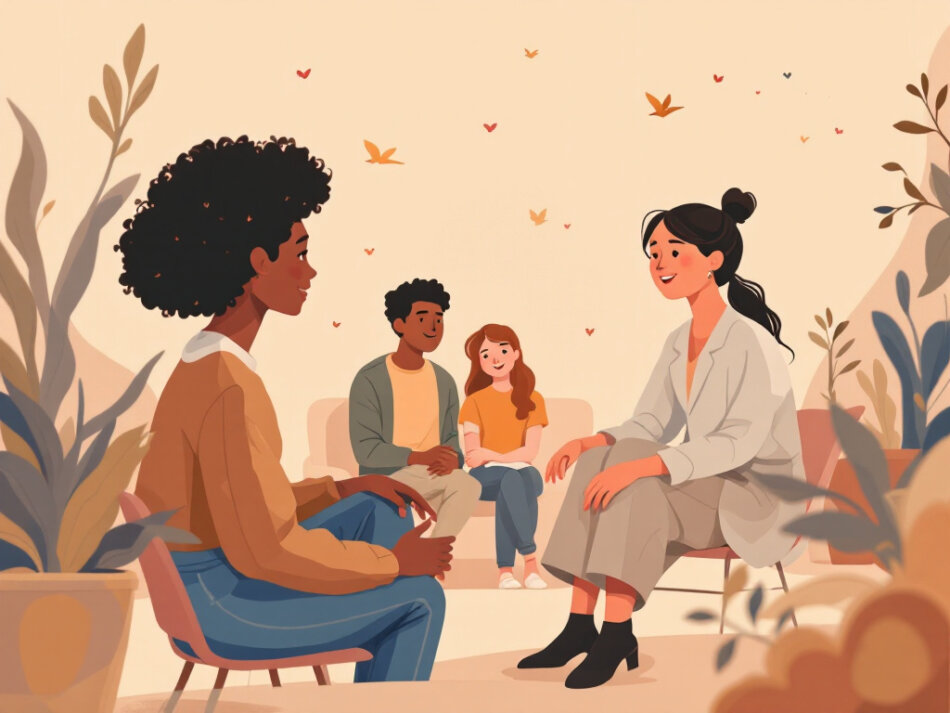Emotional expression challenges
If your teen finds it hard to share what’s on their mind, you’re not alone. Many adolescents encounter roadblocks when it comes to identifying and expressing emotions. Therapy for teens who struggle to express emotions can help you and your child understand these barriers, equipping them with tools to navigate stress, build resilience, and communicate more effectively.
Why teens struggle
Adolescence is a time of rapid brain development, hormonal shifts, and social pressures. These factors can combine to:
- Create fear of judgment or rejection
- Lead to suppression of vulnerable feelings
- Fuel confusion about complex emotions
When teens bottle up emotions, they may act out, withdraw, or struggle academically and socially. Recognizing these patterns is the first step toward finding the right therapeutic approach.
Impact on well-being
Unexpressed emotions can affect your teen’s overall health:
- Increased anxiety and irritability
- Heightened risk of depression or self-harm
- Difficulty forming healthy relationships
Early intervention helps prevent these issues from escalating. Holistic and creative therapies provide nonverbal outlets that feel more accessible than traditional talk therapy.
Expressive therapy approaches
Creative and experiential therapies invite teens to explore feelings through art, movement, nature, and play rather than relying solely on words. You can tailor programs to your teen’s interests, ensuring greater engagement and sustained progress.
Art and music therapy
Art and music therapy encourages self-exploration through drawing, painting, songwriting, or improvisation. These approaches help teens:
- Visualize and externalize emotions
- Unlock nonverbal communication channels
- Reflect on internal experiences
Many centers offer art and music therapy for teens alongside clinical support.
Equine therapy
Working with horses can be transformative. Through activities like grooming, leading, and riding, your teen can:
- Develop trust and empathy
- Observe and respond to nonverbal cues
- Learn responsibility and self-confidence
Programs such as equine therapy for adolescents often integrate licensed therapists to guide emotional insights.
Outdoor and adventure therapy
Nature-based activities—rock climbing, wilderness expeditions, ropes courses—create real-time challenges that mirror emotional obstacles. Outdoor therapy teaches:
- Stress management under pressure
- Teamwork and communication
- Self-reliance and problem-solving
Look for outdoor therapy and adventure programs for teens that accept insurance to make cost predictable.
Mindfulness and yoga therapy
Mindfulness practices and yoga combine breath work, movement, and meditation to ground teens in the present moment. Benefits include:
- Improved distress tolerance [1]
- Enhanced emotion regulation skills
- Reduced anxiety and improved focus
Programs like mindfulness and yoga therapy for teenagers often integrate these skills into broader treatment plans.
Comparative overview
| Modality | Key focus | Insurance options |
|---|---|---|
| Art and music therapy | Creative self-expression | Often in-network with major providers |
| Equine therapy | Nonverbal connection, empathy | Check for specialized equine providers |
| Outdoor and adventure therapy | Challenge response, teamwork | Many programs offer sliding-scale or in-network plans |
| Mindfulness and yoga therapy | Present-moment awareness, body-mind link | Increasingly covered under mental health benefits |
Holistic experiential therapy benefits
When you combine creative modalities with clinical support, you offer your teen a well-rounded path to emotional growth.
Building emotional regulation
Experiential therapies teach teens to recognize emotional triggers and practice coping strategies in real time. Techniques may include:
- Mindful breathing at the onset of strong feelings [1]
- Reflective journaling to track mood patterns
- Positive self-talk exercises to challenge negative thoughts
These skills empower your teen to pause, process, and respond rather than react impulsively.
Boosting confidence and communication
Success in hands-on activities translates into greater self-esteem and willingness to voice thoughts. For example:
- Completing an art piece encourages discussion of its meaning
- Leading a horseback exercise builds assertiveness
- Navigating a ropes course fosters trust in one’s own decisions
Over time, your teen can transfer these communication gains to family, school, and peer interactions.
Peer support and belonging
Group-based experiential programs provide a community of peers facing similar challenges. According to LLU Health, group youth therapy can reduce isolation and foster belonging [2]. Shared experiences:
- Normalize emotional struggles
- Encourage mutual accountability
- Strengthen interpersonal skills
This social “fitness center” effect can lead to a 73% improvement in emotional and social functioning [3].
Integrating clinical therapy
While holistic modalities offer engaging entry points, pairing them with evidence-based therapy ensures comprehensive care.
Individual and group sessions
Licensed therapists can provide:
- One-on-one support for personalized goal setting
- Group therapy to reinforce social learning and feedback
Combining creative outlets with clinical sessions helps teens process insights in a structured environment.
Dialectical behavior therapy (DBT)
DBT blends mindfulness, distress tolerance, emotion regulation, and interpersonal effectiveness. Research shows DBT skills help teens sustainably manage emotional challenges [1]. Your teen can practice:
- Mindful observation of thoughts and feelings
- Building tolerance for discomfort
- Communicating needs with clarity
Coordinating care
Effective programs designate a care coordinator or case manager to:
- Align experiential activities with clinical goals
- Track progress and adjust plans
- Communicate with parents and insurance providers
This integrated approach ensures nothing falls through the cracks and your teen’s journey stays on track.
Insurance coverage considerations
Cost concerns shouldn’t stand in the way of your teen’s growth. Many holistic and experiential programs accept insurance.
Finding in-network programs
Begin by checking your insurance provider’s mental health directory. Look for:
Contact programs directly to confirm your benefits, copays, and any preauthorization requirements.
Insurance-friendly modalities
Commonly covered services include:
- Art and music therapy when delivered by licensed clinicians
- Group therapy under mental health benefits
- Certain mindfulness and yoga practices if part of a treatment plan
Unusual modalities like equine or adventure therapy may require additional verification or a letter of medical necessity from your teen’s therapist.
Questions for your provider
When you speak with HR or your insurer, ask:
- Which experiential or creative therapies are in-network?
- What are my out-of-pocket costs and deductible status?
- Is preauthorization required for intensive programs?
- How many sessions per year are covered?
Document these details to avoid surprise bills and ensure consistent care.
Starting therapy journey
Once you’ve identified options, guiding your teen toward enrollment and ongoing engagement is crucial.
Assessing your teen’s needs
Collaborate with school counselors, pediatricians, and your teen’s therapist to determine:
- Primary emotional or behavioral challenges
- Preferred modes of expression (art, movement, nature)
- Scheduling constraints and location preferences
A thorough assessment helps match your teen with the most supportive environment.
Touring programs and admissions
Visiting potential facilities allows you to:
- Observe staff qualifications and interaction style
- Evaluate safety protocols and group sizes
- Discuss treatment plans and family involvement
Ask for sample schedules and an outline of how creative activities integrate with clinical therapy.
Supporting ongoing progress
Your involvement makes a difference:
- Create a judgment-free zone at home for sharing insights [4]
- Listen actively rather than relying on “autobiographical listening” [4]
- Encourage self-care routines—sleep, nutrition, and enjoyable family time
Celebrate milestones and remain flexible as your teen masters new emotional skills.
Conclusion
When traditional talk therapy falls short, holistic and creative programs can transform your teen’s ability to express emotions. By combining expressive therapies with evidence-based clinical support and leveraging insurance coverage, you create a strong foundation for lasting emotional regulation, confidence, and healthy communication. Take the first step today toward a more expressive, resilient future for your teen.










